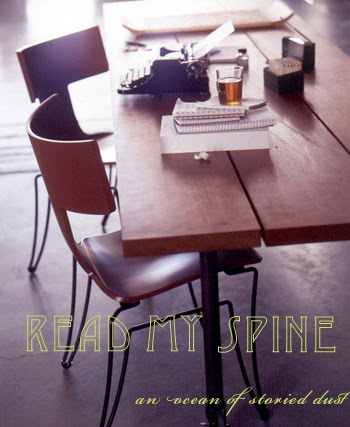
10.28.2009
Coveted: Statement pieces

10.24.2009
Go Fauve


Unpacking my library

10.22.2009
Tonight: Yvonne Jacquette Woodcuts at Mary Ryan Gallery
 Yvonne Jacquette, Chrysler Building Flanked by High-Rise Buildings, 2009. woodcut on okawara paper; 35 5/8 x 23 1/2 inches. edition of 75
Yvonne Jacquette, Chrysler Building Flanked by High-Rise Buildings, 2009. woodcut on okawara paper; 35 5/8 x 23 1/2 inches. edition of 75The metropolis -- in its mysterious, monumental, intimate, and unseen angulations -- is the muse and protagonist of artist Yvonne Jacquette's body of work, comprising sketches, paintings, and woodcuts.
Tonight, the first retrospective of Jacquette's woodcuts opens at Mary Ryan
Gallery, located in the heart of the Chelsea Gallery district. The exhibition is accompanied by a full-color catalogue available for a modest sum of $15, and will travel to the Springfield Museum of Art in Springfield, Missouri.
I look forward to seeing Jacquette's new works, such as the woodcut of the Chrysler Building above.
10.15.2009
Strawberries in Murnau

I’m trying to make sense of a thread of correspondences written one unseasonably hot summer in 1911. The place is Murnau, a rustic village in Bavaria, Germany. An artist has arrived to the house after an extended visit with family and relatives in Moscow and Odessa. She is not there, and so thus begins the chain of correspondence:
10.11.2009
Art I love: The Art of Provocation

Immaturity is not always innate or imposed by others.
There is also an immaturity which culture batters us against when it submerges us
and we do not manage to hoist ourselves up to its level. We are "infantilized" by all
"higher" forms. Man, tortured by his mask, fabricates secretly, for his own usage, a sort of "subculture":
a world made out of the refuse of a higher world of culture, a domain of trash, immature myths,
inadmissible passions...a secondary domain of compensation.
That is where a certain shameful poetry is born, a certain compromising beauty...
Are we not close to Pornografia?
--Witold Gombrowicz, in the preface of his 1966 novel, Pornografia10.07.2009
Madrelingua: Anna, ti amo!

Of course I'm talking about Anna Dello Russo, the statuesque and aristocratic editrix of Vogue Nippon. Like your humble narrator, ADR is of Apulian origin, and even received a Master's in Literature and Art History( Gianfranco Ferre was her professor). She describes herself as a "collector" of haute couture. Dello Russo is also the muse for bloggers the Sartorialist, Garance Doré, et al. In this aspect, her intense presence and fearlessness when it comes to mixing colors and textures place her far beyond fashion's madding crowd.
10.06.2009
Art I love: Beyond the Liminal with Atta Kim


10.05.2009
The Death of Taste: Reflections on the Shuttering of Gourmet Magazine




